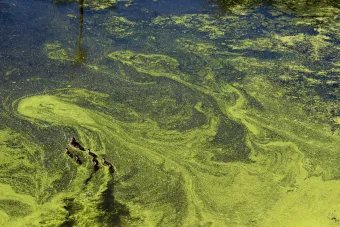
- NOC scientists have developed a new genetic testing approach to be used alongside artificial intelligence (AI) to test for toxic algae.
- This form of algae can result in severe and fatal sickness in humans.
- The method was able to predict a rise in toxic algae at least four weeks earlier than the microscope method.
- This exciting new method can be more accurate, significantly faster and potentially far cheaper.
The National Oceanography Centre (NOC) has developed a new scientific approach to be used alongside artificial intelligence (AI) to test for toxic algae that can result in severe and fatal sickness in humans.
A new paper published in ‘Harmful Algae’ highlights the benefits of using the new methods to predict blooms of harmful algae in marine populations, designed to enable local authorities to mitigate the risks to both people and wildlife.
NOC scientists tested water over a six-month period from September 2021 until March 2022 in St Austell Bay in Cornwall - famous for its production of oysters, mussels and clams, and is a well-known hotspot for toxic marine algae. The plant periodically blooms near seafood production areas, which can lead to the potential contamination of seafood. If this is consumed, it can result in debilitating and sometimes fatal syndromes that attack the gut and nervous system.
Working in collaboration with Cornwall Port Health Authority, the University of Glasgow, the University of Exeter, and Cefas, scientists tested water for the DNA of a species called Dinophysis accuminata in three seafood production sites, Porthallow, Mevagissey and Ropehaven. Dinophysis produces a toxin called okadaic acid, which attacks the digestive system and can cause severe pain and sickness.
In 2019 the UK had an outbreak of food poisoning, with 13 reported illnesses involving okadaic acid. This is a heat stable toxin found in various species of shellfish, which can pose a risk of sickness even once cooked.
The standard method of identifying this toxin involves the observation of water samples under a microscope and using a very skilled ‘taxonomist’ to identify the toxic cells and count them. This approach is time consuming and expensive, so in order to help propose an alternative solution, NOC adopted new methods, using molecular biology to identify and count genetic sequences in a fraction of the time and with far greater sensitivity and accuracy.
This new molecular biology-based approach has enabled NOC’s industry leading team to identify the same trend as the microscope-based method and was able to predict a rise in toxic algae at least 4 weeks earlier than the microscope method. The molecular testing was used to inform the validity of an AI-based model for predicting Dinophysis blooms, developed by the University of Glasgow and University of Exeter.
Dr Jonathan McQuillian, Molecular Biologist at NOC, said: “We’re embracing the move to genetic testing methods coupled with AI as it’s an incredibly important scientific tool that can help UK businesses mitigate health risks in seafood production. This is the first example of this approach being used alongside the UK’s statutory algal surveillance program, and this breakthrough further pushes for the adoption of DNA testing in early warning systems.
“DNA testing is still relatively new technology with clear advantages over traditional microbiological testing methods, which should reassure the public that the stringency and standards of testing food and water supplies for harmful microbes are utilising the very latest technology.”
Further development of these methods, particularly their integration with ocean-deployed sensors or handheld testers, will revolutionise the way in which the UK monitors biohazards, not just in the marine sector, but also across healthcare, military, and industrial industries.